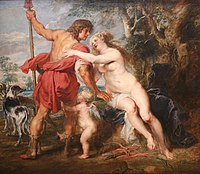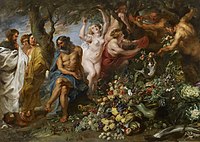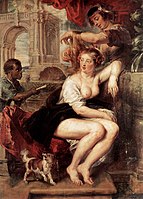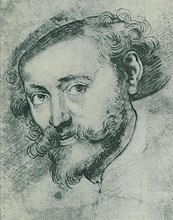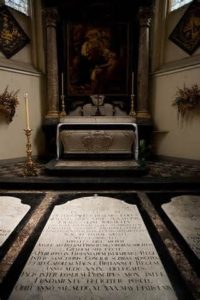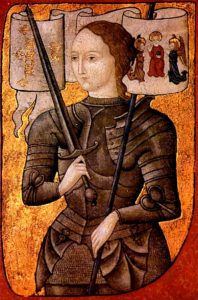 On this day in 1431, peasant girl, national heroine of France, Catholic saint, The Maid of Orléans, Saint Joan of Arc was executed by burning in Rouen, France at the age of 19. Born around the year 1412 in Domrémy, a village which was then in the duchy of Bar (later annexed to the province of Lorraine and renamed Domrémy-la-Pucelle).
On this day in 1431, peasant girl, national heroine of France, Catholic saint, The Maid of Orléans, Saint Joan of Arc was executed by burning in Rouen, France at the age of 19. Born around the year 1412 in Domrémy, a village which was then in the duchy of Bar (later annexed to the province of Lorraine and renamed Domrémy-la-Pucelle).
Joan claimed divine guidance and led the French army to several important victories during the Hundred Years’ War, which paved the way for the coronation of Charles VII. She asserted that she had visions from God that instructed her to recover her homeland from English domination. The uncrowned Charles VII sent her to the siege of Orléans as part of a relief mission. She gained prominence when she overcame the dismissive attitude of veteran commanders and lifted the siege in only nine days. Several more swift victories led to Charles VII’s coronation at Reims and settled the disputed succession to the throne. She was captured by the Burgundians, sold to the English, tried and sentenced by an ecclesiastical court.
 The Final Footprint – Joan’s ashes were cast into the Seine. A monument in Rouen dedicated to her is inscribed with the words of André Malraux: “O Jeanne, without sepulchre, without portrait, you know that the tomb of heroes is the heart of the living.” A statue in her honor was erected in the Notre Dame de Paris Cathedral, interior. Twenty-five years after the execution, Pope Callixtus III examined the trial, pronounced her innocent and declared her a martyr. Joan of Arc was beatified in 1909 and canonized in 1920. She is one of the patron saints of France, along with St. Denis, St. Martin of Tours, St. Louis IX, and St. Theresa of Lisieux.
The Final Footprint – Joan’s ashes were cast into the Seine. A monument in Rouen dedicated to her is inscribed with the words of André Malraux: “O Jeanne, without sepulchre, without portrait, you know that the tomb of heroes is the heart of the living.” A statue in her honor was erected in the Notre Dame de Paris Cathedral, interior. Twenty-five years after the execution, Pope Callixtus III examined the trial, pronounced her innocent and declared her a martyr. Joan of Arc was beatified in 1909 and canonized in 1920. She is one of the patron saints of France, along with St. Denis, St. Martin of Tours, St. Louis IX, and St. Theresa of Lisieux.
Down to the present day, Joan of Arc has remained a significant figure in Western culture. From Napoleon onward, French politicians of all leanings have invoked her memory. Writers and composers who have created works about her include: Shakespeare (Henry VI, Part 1), Voltaire (see below) (The Maid of Orleans poem), Schiller (The Maid of Orleans play), Verdi (Giovanna d’Arco), Tchaikovsky (The Maid of Orleans opera), Mark Twain (Personal Recollections of Joan of Arc), and George Bernard Shaw. Depictions of her continue in film, theatre, television, video games, music and performance.
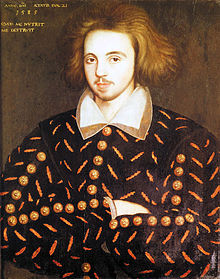 On this day in 1593, playwright, poet and translator of the Elizabethan era, Kit Marlowe, Christopher Marlowe, died in Deptford, Kent, England at the age of 29. Baptised 26 February 1564 in Canterbury, Kent, England. Marlowe was the foremost Elizabethan tragedian of his day. He greatly influenced William Shakespeare, who was born in the same year as Marlowe and who rose to become the pre-eminent Elizabethan playwright after Marlowe’s mysterious early death. Marlowe’s plays are known for the use of blank verse and their overreaching protagonists.
On this day in 1593, playwright, poet and translator of the Elizabethan era, Kit Marlowe, Christopher Marlowe, died in Deptford, Kent, England at the age of 29. Baptised 26 February 1564 in Canterbury, Kent, England. Marlowe was the foremost Elizabethan tragedian of his day. He greatly influenced William Shakespeare, who was born in the same year as Marlowe and who rose to become the pre-eminent Elizabethan playwright after Marlowe’s mysterious early death. Marlowe’s plays are known for the use of blank verse and their overreaching protagonists.
A warrant was issued for Marlowe’s arrest on 18 May 1593. No reason was given for it, though it was thought to be connected to allegations of blasphemy—a manuscript believed to have been written by Marlowe was said to contain “vile heretical conceipts”. On 20 May, he was brought to the court to attend upon the Privy Council for questioning. There is no record of their having met that day, however, and he was commanded to attend upon them each day thereafter until “licensed to the contrary”. Ten days later, he was stabbed to death by Ingram Frizer. Whether or not the stabbing was connected to his arrest remains unknown.
Marlowe’s first play performed on the regular stage in London, in 1587, was Tamburlaine the Great, about the conqueror Timur (Tamerlane), who rises from shepherd to warlord. It is among the first English plays in blank verse, and, with Thomas Kyd’s The Spanish Tragedy, generally is considered the beginning of the mature phase of the Elizabethan theatre. Tamburlaine was a success, and was followed with Tamburlaine the Great, Part II.
The two parts of Tamburlaine were published in 1590; all Marlowe’s other works were published posthumously. The sequence of the writing of his other four plays is unknown; all deal with controversial themes.
- The Jew of Malta (first published as The Famous Tragedy of the Rich Jew of Malta), about the Jew Barabas’ barbarous revenge against the city authorities, has a prologue delivered by a character representing Machiavelli. It was probably written in 1589 or 1590, and was first performed in 1592. It was a success, and remained popular for the next fifty years. The play was entered in the Stationers’ Register on 17 May 1594, but the earliest surviving printed edition is from 1633.
- Edward the Second is an English history play about the deposition of King Edward II by his barons and the Queen, who resent the undue influence the king’s favourites have in court and state affairs. The play was entered into the Stationers’ Register on 6 July 1593, five weeks after Marlowe’s death. The full title of the earliest extant edition, of 1594, is The troublesome reigne and lamentable death of Edward the second, King of England, with the tragicall fall of proud Mortimer.
- The Massacre at Paris is a short and luridly written work, the only surviving text of which was probably a reconstruction from memory of the original performance text, portraying the events of the Saint Bartholomew’s Day Massacre in 1572, which English Protestants invoked as the blackest example of Catholic treachery. It features the silent “English Agent”, whom subsequent tradition has identified with Marlowe himself and his connections to the secret service. The Massacre at Paris is considered his most dangerous play, as agitators in London seized on its theme to advocate the murders of refugees from the low countries and, indeed, it warns Elizabeth I of this possibility in its last scene. Its full title was The Massacre at Paris: With the Death of the Duke of Guise.
- Doctor Faustus (or The Tragical History of the Life and Death of Doctor Faustus), based on the German Faustbuch, was the first dramatised version of the Faust legend of a scholar’s dealing with the devil. While versions of “The Devil’s Pact” can be traced back to the 4th century, Marlowe deviates significantly by having his hero unable to “burn his books” or repent to a merciful God in order to have his contract annulled at the end of the play. Marlowe’s protagonist is instead carried off by demons, and in the 1616 quarto his mangled corpse is found by several scholars.
The Final Footprint

Marlowe was buried in an unmarked grave in the churchyard of St. Nicholas, Deptford immediately after the inquest, on 1 June 1593.
The mightiest kings have had their minions;
Great Alexander loved Hephaestion,
The conquering Hercules for Hylas wept;
And for Patroclus, stern Achilles drooped.
And not kings only, but the wisest men:
The Roman Tully loved Octavius,
Grave Socrates, wild Alcibiades.

The Muse of Poetry, part of the Marlowe Memorial in Canterbury
A Marlowe Memorial in the form of a bronze sculpture of The Muse of Poetry by Edward Onslow Ford was erected by subscription in Buttermarket, Canterbury in 1891.
In July 2002, a memorial window to Marlowe – a gift of the Marlowe Society – was unveiled in Poets’ Corner in Westminster Abbey.
Come live with me and be my Love,
And we will all the pleasures prove
That hills and valleys, dales and fields,
Or woods or steepy mountain yields.
And we will sit upon the rocks,
And see the shepherds feed their flocks
By shallow rivers, to whose falls
Melodious birds sing madrigals.
And I will make thee beds of roses
And a thousand fragrant posies.
- The Passionate Shepherd to His Love (unknown date)
Che serà, serà:
What will be, shall be.
- Faustus, Act I, scene i, lines 47–58
- Hell hath no limits, nor is circumscrib’d
In one self place; but where we are is hell,
And where hell is, there must we ever be.- Mephistopheles, Act II, scene i, line 118
Was this the face that launch’d a thousand ships,
And burnt the topless towers of Ilium?
Sweet Helen, make me immortal with a kiss!
- Faustus, Act V, scene i, lines 91–93
 On this day in 1640, Flemish Baroque painter, Pieter Paul Rubens died in Antwerp at the age of 62 from heart failure, which was a result of his chronic gout. born in Siegen in Germany on 28 June 1577.
On this day in 1640, Flemish Baroque painter, Pieter Paul Rubens died in Antwerp at the age of 62 from heart failure, which was a result of his chronic gout. born in Siegen in Germany on 28 June 1577.
His unique and popular Baroque style emphasized movement, colour, and sensuality, which followed the immediate, dramatic artistic style promoted in the Counter-Reformation. Rubens specialized in making altarpieces, portraits, landscapes, and history paintings of mythological and allegorical subjects.
In addition to running a large studio in Antwerp that produced paintings popular with nobility and art collectors throughout Europe, Rubens was a classically educated humanist scholar and diplomat who was knighted by both Philip IV of Spain and Charles I of England. Rubens was a prolific artist. The catalogue of his works by Michael Jaffé lists 1,403 pieces, excluding numerous copies made in his workshop. The Museo del Prado owns the largest collection of Rubens’ paintings, and one of the finest as well, and almost all of it comes from Spain’s royal collections.
Gallery
- Early paintings
- Historical portraits
- Landscapes
- Mythological
- Nude
- Helena Fourment and related pictures
The Final Footprint – Rubens was interred in Saint Jacob’s church, Antwerp.
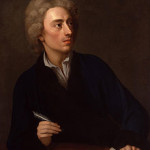 On this day in 1744, English poet, best known for his satirical verse and for his translation of Homer and for his use of the heroic couplet, Alexander Pope died at the age of 56 in his villa in Twickenham surrounded by friends.
On this day in 1744, English poet, best known for his satirical verse and for his translation of Homer and for his use of the heroic couplet, Alexander Pope died at the age of 56 in his villa in Twickenham surrounded by friends.
Perhaps best known for his satirical and discursive poetry, including The Rape of the Lock, The Dunciad, and An Essay on Criticism, as well as for his translation of Homer. After Shakespeare, Pope is the second-most quoted writer in the English language, per The Oxford Dictionary of Quotations, some of his verses having even become popular idioms in common parlance (e.g., Damning with faint praise).
Pope’s poetic career testifies to his indomitable spirit in the face of disadvantages, of health and of circumstance. The poet and his family were Catholics and thus fell subject to the Test Acts, prohibitive measures which severely hampered the prosperity of their co-religionists after the abdication of James II; one of these banned them from living within ten miles of London, and another from attending public school or university. He was taught to read by his aunt and became a lover of books. He learned French, Italian, Latin, and Greek by himself, and discovered Homer at the age of six. As a child Pope survived being once trampled by a cow, but when he was 12 began struggling with tuberculosis of the spine (Pott disease), along with fits of crippling headaches which troubled him throughout his life.
In the year 1709, Pope showcased his precocious metrical skill with the publication of Pastorals, his first major poems. They earned him instant fame. By the time he was 23 he had written An Essay on Criticism, released in 1711. A kind of poetic manifesto in the vein of Horace’s Ars Poetica, the essay was met with enthusiastic attention.
The Rape of the Lock, perhaps the poet’s most famous poem, appeared first in 1712, followed by a revised and enlarged version in 1714. When Lord Petre forcibly snipped off a lock from Miss Arabella Fermor’s head (the “Belinda” of the poem), the incident gave rise to a high-society quarrel between the families. With the idea of allaying this, Pope treated the subject in a playful and witty mock-heroic epic. The narrative poem brings into focus the onset of acquisitive individualism and conspicuous consumption, where purchased goods assume dominance over moral agency.
A folio comprising a collection of his poems appeared in 1717, together with two new ones written about the passion of love. These were Verses to the Memory of an Unfortunate Lady and the famous proto-romantic poem Eloisa to Abelard. Though Pope never married, about this time he became strongly attached to Lady M. Montagu, whom he indirectly referenced in the popular poem Eloisa to Abelard, and to Martha Blount, with whom his friendship continued throughout his life.
As his health was failing, and when told by his physician, on the morning of his death, that he was better, Pope replied: “Here am I, dying of a hundred good symptoms”.
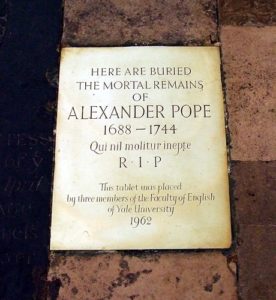 The Final Footprint – He lies buried in the nave of the Church of St Mary the Virgin in Twickenham. In his will Pope asked to be carried at his funeral by 6 of the poorest men of Twickenham, kitted out in grey mourning suits; his manuscripts & publications he left to Lord Bolingbroke “either to be preserved or destroyed”. His epitaph in Latin; Qui nil molitur inepte, in nothing was he inept.
The Final Footprint – He lies buried in the nave of the Church of St Mary the Virgin in Twickenham. In his will Pope asked to be carried at his funeral by 6 of the poorest men of Twickenham, kitted out in grey mourning suits; his manuscripts & publications he left to Lord Bolingbroke “either to be preserved or destroyed”. His epitaph in Latin; Qui nil molitur inepte, in nothing was he inept.
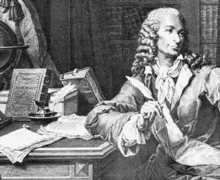 On this day in 1778, French Enlightenment writer, historian and philosopher famous for his wit and for his advocacy of civil liberties, including freedom of religion, freedom of expression, free trade and separation of church and state, Voltaire died in Paris at the age of 83. Born François-Marie Arouet in Paris either on 21 November 1694 or 20 February 1694. Voltaire was a versatile writer, producing works in almost every literary form, including plays, poems, novels, essays, and historical and scientific works. He wrote more than 20,000 letters and more than 2,000 books and pamphlets. He was an outspoken advocate, despite the risk this placed him in under the strict censorship laws of the time. As a satirical polemicist, he frequently made use of his works to criticize intolerance, religious dogma, and the French institutions of his day.
On this day in 1778, French Enlightenment writer, historian and philosopher famous for his wit and for his advocacy of civil liberties, including freedom of religion, freedom of expression, free trade and separation of church and state, Voltaire died in Paris at the age of 83. Born François-Marie Arouet in Paris either on 21 November 1694 or 20 February 1694. Voltaire was a versatile writer, producing works in almost every literary form, including plays, poems, novels, essays, and historical and scientific works. He wrote more than 20,000 letters and more than 2,000 books and pamphlets. He was an outspoken advocate, despite the risk this placed him in under the strict censorship laws of the time. As a satirical polemicist, he frequently made use of his works to criticize intolerance, religious dogma, and the French institutions of his day.
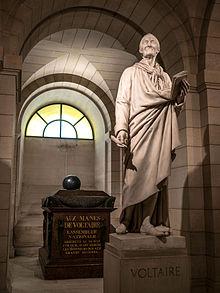 The Final Footprint – Because of his well-known criticism of the Church, which he had refused to retract before his death, Voltaire was denied a Christian burial, but friends managed to bury his body secretly at the Abbey of Scellières in Champagne before this prohibition had been announced. His heart and brain were embalmed separately. On 11 July 1791, the National Assembly of France, which regarded him as a forerunner of the French Revolution, had his remains brought back to Paris to enshrine him in the Panthéon. It is estimated that a million people attended the procession, which stretched throughout Paris. There was an elaborate ceremony, complete with an orchestra, and the music included a piece that André Grétry had composed specially for the event. A widely repeated story, that the remains of Voltaire were stolen by religious fanatics in 1814 or 1821 during the Pantheon restoration and thrown into a garbage heap, is false. Such rumours resulted in the coffin being opened in 1897, which confirmed that his remains were still present. Other notable Final Footprints at the Panthéon include: Louis Braille, Pierre and Marie Curie, Alexandre Dumas, Victor Hugo, André Malraux, Jean-Jacques Rousseau, and Émile Zola.
The Final Footprint – Because of his well-known criticism of the Church, which he had refused to retract before his death, Voltaire was denied a Christian burial, but friends managed to bury his body secretly at the Abbey of Scellières in Champagne before this prohibition had been announced. His heart and brain were embalmed separately. On 11 July 1791, the National Assembly of France, which regarded him as a forerunner of the French Revolution, had his remains brought back to Paris to enshrine him in the Panthéon. It is estimated that a million people attended the procession, which stretched throughout Paris. There was an elaborate ceremony, complete with an orchestra, and the music included a piece that André Grétry had composed specially for the event. A widely repeated story, that the remains of Voltaire were stolen by religious fanatics in 1814 or 1821 during the Pantheon restoration and thrown into a garbage heap, is false. Such rumours resulted in the coffin being opened in 1897, which confirmed that his remains were still present. Other notable Final Footprints at the Panthéon include: Louis Braille, Pierre and Marie Curie, Alexandre Dumas, Victor Hugo, André Malraux, Jean-Jacques Rousseau, and Émile Zola.
#RIP #OTD in 1960 poet (My Sister, Life), novelist (Doctor Zhivago), literary translator Boris Pasternak died of lung cancer in his dacha in Peredelkino near Mosscow, aged 70. Peredelkino Cemetery
#RIP #OTD in 1967 actor (The Invisible Man, The Adventures of Robin Hood, The Wolf Man, Casablanca, Kings Row, Notorious, Lawrence of Arabia) Claude Rains died from cirrhosis of the liver, aged 77. Red Hill Cemetery in Moultonborough, New Hampshire
#RIP #OTD in 1993 jazz composer, bandleader, piano and synthesizer player, poet, Sun Ra died at Princeton Baptist Medical Center, Birmingham, Alabama, aged 79. Elmwood Cemetery, Birmingham
Have you planned yours yet?
Follow TFF on twitter @RIPPTFF













